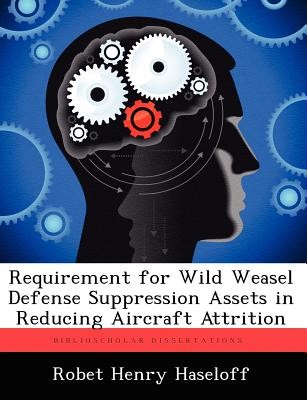
- We will send in 10–14 business days.
- Author: Robet Henry Haseloff
- Publisher: BiblioScholar
- ISBN-10: 1249285682
- ISBN-13: 9781249285687
- Format: 18.9 x 24.6 x 0.6 cm, softcover
- Language: English
- SAVE -10% with code: EXTRA
Requirement for Wild Weasel Defense Suppression Assets in Reducing Aircraft Attrition (e-book) (used book) | bookbook.eu
Reviews
Description
The combat effectiveness of tactical airpower can be assured during a conflict only if attrition is maintained at minimum levels. In today's high threat environment, the Warsaw Pact nations outnumber the NATO allies in front line aircraft by a factor of 2.4 to 1 and have over 1800 surface-to-air missile launchers and 1500 search radar systems. Therefore, we must have an effective and efficient defense suppression capability to effectively accomplish the counterair mission. Effective suppression of enemy radar systems is directly associated with attrition rates of fighter aircraft operating in the vicinity of the forward edge of the battle area (FEBA). The focus of this thesis is to determine if Wild Weasel assets are required during a conflict and ascertain when they become cost effective in reducing attrition of strike aircraft. This study examines three aspects of the suppression of enemy air defense (SEAD) mission. First is the history of electronic combat. This thesis covers the history of aerial electronic combat beginning with the introduction of radar controlled antiaircraft gun and missile systems after World War II. Other areas discussed include the development of the first Wild Weasel aircraft during the Vietnam conflict and the lessons learned from the 1973 Arab-Israeli War. Recent hostilities include the Falklands conflict, the Bekka Valley debacle, and the 1986 raid on Libya by U.S. forces. The second aspect covers the Soviet radar threat. Presentation of the Soviet threat discusses doctrine, employment of the Soviet air defense system, the capabilities and weaknesses of each Soviet radar system, and concludes with an insight to future Soviet weapons systems. The final portion of the thesis provides an analysis of fighter attrition and a cost effectiveness analysis to determine when the Wild Weasel force reaches a cost effective break even point.
EXTRA 10 % discount with code: EXTRA
The promotion ends in 18d.18:38:17
The discount code is valid when purchasing from 10 €. Discounts do not stack.
- Author: Robet Henry Haseloff
- Publisher: BiblioScholar
- ISBN-10: 1249285682
- ISBN-13: 9781249285687
- Format: 18.9 x 24.6 x 0.6 cm, softcover
- Language: English English
The combat effectiveness of tactical airpower can be assured during a conflict only if attrition is maintained at minimum levels. In today's high threat environment, the Warsaw Pact nations outnumber the NATO allies in front line aircraft by a factor of 2.4 to 1 and have over 1800 surface-to-air missile launchers and 1500 search radar systems. Therefore, we must have an effective and efficient defense suppression capability to effectively accomplish the counterair mission. Effective suppression of enemy radar systems is directly associated with attrition rates of fighter aircraft operating in the vicinity of the forward edge of the battle area (FEBA). The focus of this thesis is to determine if Wild Weasel assets are required during a conflict and ascertain when they become cost effective in reducing attrition of strike aircraft. This study examines three aspects of the suppression of enemy air defense (SEAD) mission. First is the history of electronic combat. This thesis covers the history of aerial electronic combat beginning with the introduction of radar controlled antiaircraft gun and missile systems after World War II. Other areas discussed include the development of the first Wild Weasel aircraft during the Vietnam conflict and the lessons learned from the 1973 Arab-Israeli War. Recent hostilities include the Falklands conflict, the Bekka Valley debacle, and the 1986 raid on Libya by U.S. forces. The second aspect covers the Soviet radar threat. Presentation of the Soviet threat discusses doctrine, employment of the Soviet air defense system, the capabilities and weaknesses of each Soviet radar system, and concludes with an insight to future Soviet weapons systems. The final portion of the thesis provides an analysis of fighter attrition and a cost effectiveness analysis to determine when the Wild Weasel force reaches a cost effective break even point.


Reviews